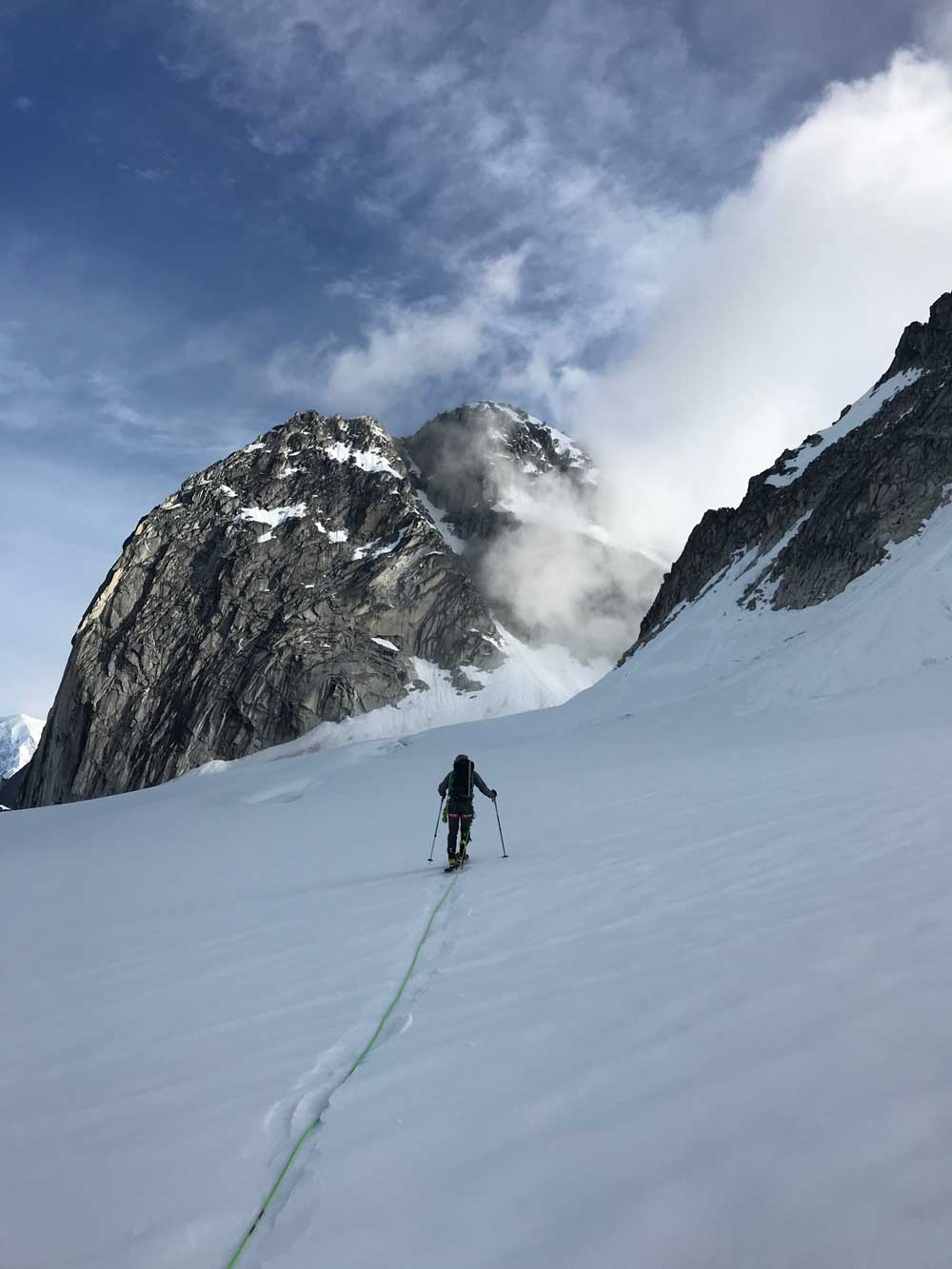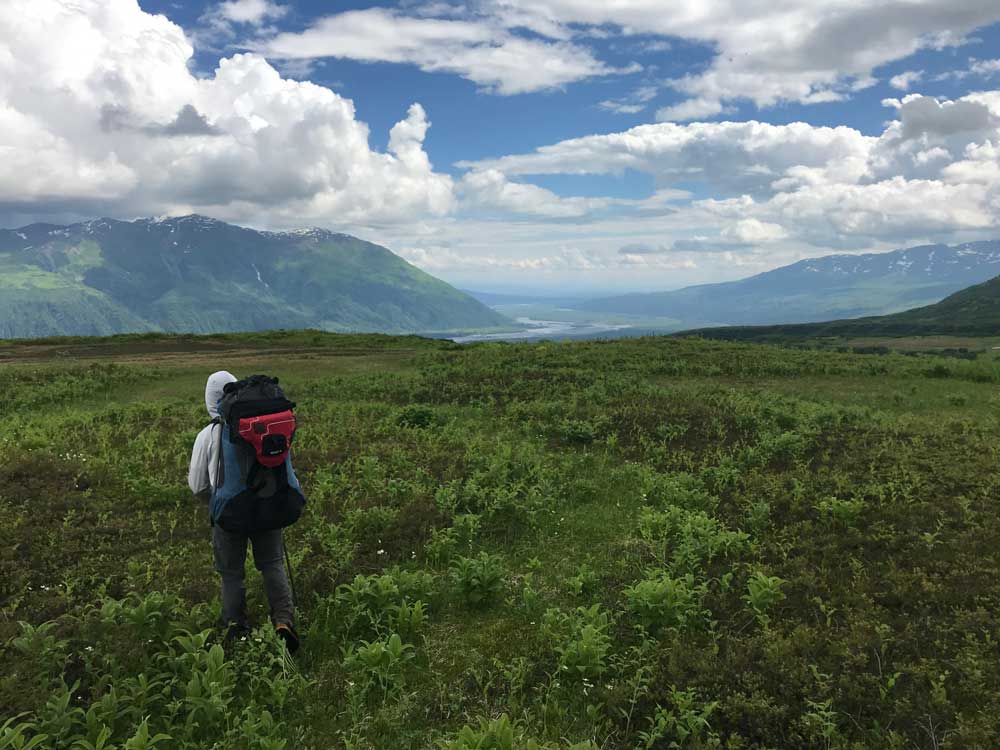On July 1, rangers Jake Beren and Frank Preston got dropped off at the Pika Glacier upper airstrip for a couple days of climbing and a few days of traversing back to Talkeetna. With near perfect weather July 2, Jake and Frank swapped leads of rock and snow pitches on The Lost Marsupial, finishing the route but opting not to climb the snowy ridge to the Throne’s summit due to warm and loose snow conditions.
 Approaching the Throne. NPS Photo / Jake Beren
Approaching the Throne. NPS Photo / Jake BerenThe weather continued to hold, and on July 3 they climbed the South Face of Middle Troll.
Notes on the routes: The Lost Marsupial had significant amounts of snow on the route, mainly on the 3rd and 4th class terrain. The rock was dry, and the route is not threatened by avalanches, but there were wet loose sluffs coming down on either side of the route throughout the day. The summit ridge seemed dangerous due to warm daytime highs and barely freezing overnight lows. A second rope was helpful for some of the rappels lower on the route, but many of the upper rappels are short to avoid getting ropes stuck. With more rappels, a party could descend with only a single rope.
The South Face of Middle Troll has some extremely high quality pitches, but it also wanders through some very loose rock especially on the bottom of the route. To avoid the loose rock, you can stay on the snow for quite a ways (~100 meters above the bergschrund) and traverse onto the route at a fairly obvious 5.7/5.8 left corner crack. As Joe Puryear’s Alaska Climbing guidebook says, a single rope is preferable for descending the route, as shorter rappels avoid getting your rope stuck and limits the chance of having your rope pull loose rock down.
 Frank following on the upper part of Lost Marsupial, the Trolls in the background. NPS Photo / Jake Beren
Frank following on the upper part of Lost Marsupial, the Trolls in the background. NPS Photo / Jake BerenWith plenty of climbing waiting for next time, Jake and Frank launched from the Pika airstrip early on Independence Day, headed for Talkeetna under human power. An Alaska Mountaineering School 12-day course had put in a track to Grizzly Gap, making for easy walking without snow floatation in the firm morning snow conditions. The descent to the Granite Glacier went well, with a combination of plunge-stepping in wet snow, walking on loose rock, and one 15 meter rappel over the bergschrund. This area is threatened by snow and rock from above, so timing and efficient movement are important.
 Glorious alpine tundra walking down Wildhorse Valley. NPS Photo / Jake Beren
Glorious alpine tundra walking down Wildhorse Valley. NPS Photo / Jake BerenThe lower Granite Glacier is mostly covered by large granite boulders and rocks, and every one of them seems to be loose. On the map it is only 3 miles, but this section can be slow and tedious as footing can be tricky and large boulders often move under foot. The exit off the toe of the glacier seems especially challenging if not dangerous, as one logical route heads off the Granite to the east, onto the lateral moraine and then down to the gravel bar next to the Granite River.
The easy travel on the gravel bar is short-lived if you head towards Wildhorse Pass, because the bushwacking starts quickly. Jake is new to Alaskan bushwacking, and this 600 vertical feet was a stout introduction. Once at the base of Wildhorse Pass, Jake and Frank found excellent tundra camping with plentiful water and early spring conditions.

Mellow travel before the bushwack, Tokositna River in the background. NPS Photo / Jake Beren
Overnight Jake and Frank had some rain on the tent, but woke to clearing skies for the ascent over Wildhorse Pass. Snow conditions on the short climb were nice for crampons, although a team could have opted for kicking steps without crampons also. From the pass, the Wildhorse Valley looks inviting and fun, if not fast travel through green tundra. After about 3 miles of easy strolling, the willow and alders start, but moose trails wander and link meadows for a couple extra miles of easy walking. This section is fun, but one cannot help think about the calm before the storm as the bushwacking starts in earnest before the final descent to the Kanikula River.
Roger Robinson talks about a bear trail descending from a knob near point 1920 on the USGS 15-minute topo map, and Jake and Frank were able to find the start of this old trail and follow it for a few hundred feet of the initial descent. It is overgrown and at times hard to follow, even when standing on it. All in all, with this type of bushwacking, any semblance of a trail is better than nothing, so finding the start can be helpful. At some point however, the trail fades and the schwack becomes world-class. Celebrate if you can maintain a ½ mile per hour pace through the dense alder and prolific devil’s club. And expect it to get worse before it gets better.
Jake and Frank opted for an extra ½ mile of walking to the confluence of the Kanikula and Wildhorse Creek, as the creek is a clear and beautiful stream with an inviting gravel bar for inflating packrafts and filling all water containers with drinkable water. The Kanikula, Tokositna and Chulitna are all unappetizing silty rivers, and Jake and Frank had been reminded to find and carry drinking water for the long float. This put-in is a spectacular scenic put-in, with views up towards the Kanikula Glacier and Avalanche Spire.
The Tokositna River comes in shortly, and in warm temps can be high and feel hectic for flatwater. Gravel bars and logjams keep floaters on their toes through the initial section, but as the Tok rounds the south side of the Tokosha Mountains, the views continue to impress. The river channelizes somewhere south of the Tokoshas, although it is constantly changing location, and is currently north of river on the USGS maps.
 World-class bushwhacking. NPS Photo / Jake Beren
World-class bushwhacking. NPS Photo / Jake BerenJake and Frank chose to camp on a gravel bar across the Tok from Bunco Lake, as this seems like an obvious landmark for getting fresh water. The Tok switches direction significantly from southeast to northeast or even north, and the outlet creek from Bunco is easy to find. The views back into the Alaska Range were amazing, and with no threat of rain, Jake and Frank slept with only a mesh tent for bugs but no rain fly. It isn’t every trip out of the Range that you can do that!
 Frank floating out on the Tokositna River. NPS Photo / Jake Beren
Frank floating out on the Tokositna River. NPS Photo / Jake BerenWith an estimated 45 miles to go, Jake and Frank got on the water in the morning after ferrying across to fill with fresh water from Bunco. As the Ruth River comes in, the speed picks up a bit, and the river becomes a fast wide Class II for a few miles. A stop at Alder Creek confluence allowed Jake and Frank to stretch the legs, but Alder Creek was silty so filling water bottles wasn’t a great option. After Alder Creek, the Tok leaves Denali National Park before flowing into the Chulitna River. The Chulitna again increases the speed of the current, and it becomes hectic with gravel bars and logjams.
Just upstream of the Parks Highway bridge at Mile 131 the Chulitna becomes a single channel and speeds up even more. Jake and Frank made one last water fill-up and stretching break below the bridge, as there are a few clear creeks coming in from river left. The weather was hot and clear, so the sky was filled with a constant stream of scenic flights from Talkeetna into the Alaska Range. Closer to Talkeetna, jet boats cruised around in the Chulitna. Jake and Frank took out at the end of Main Street in Talkeetna, and walked the 2 blocks to the Ranger Station to finish the trip in style.
